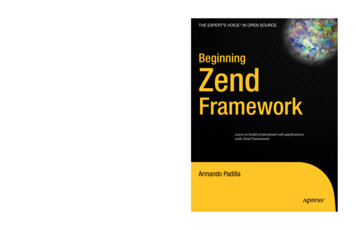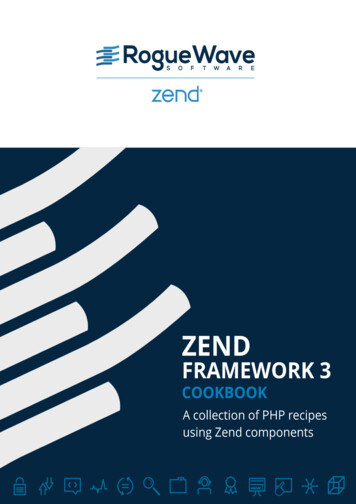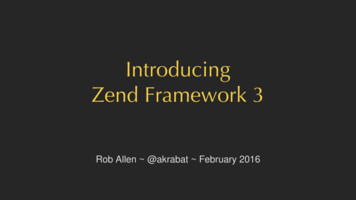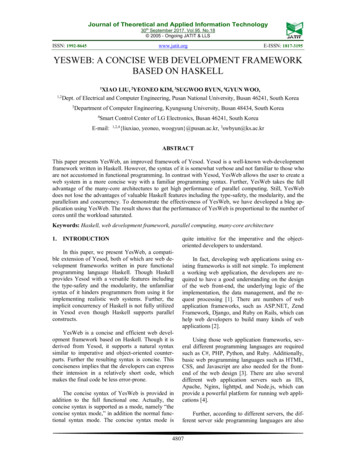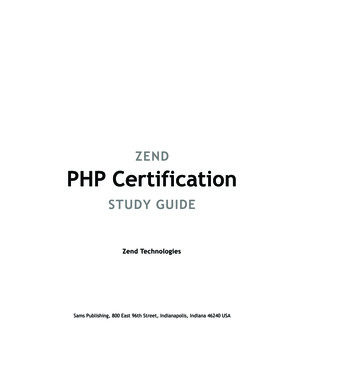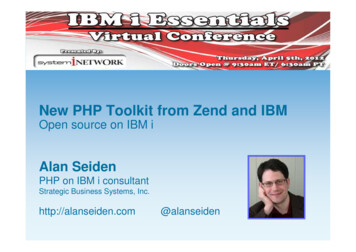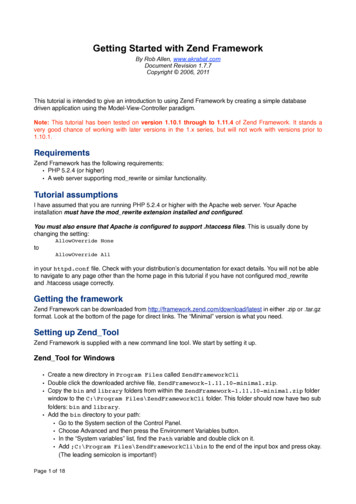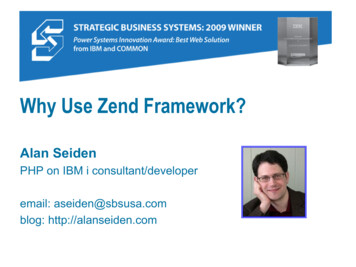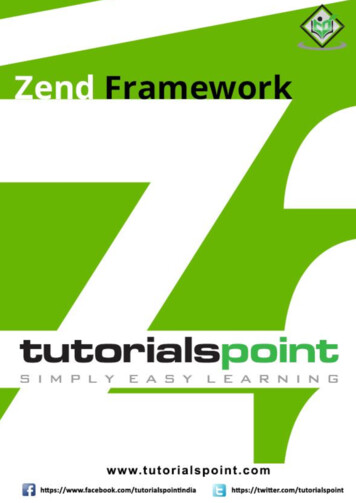
Transcription
Zend Frameworki
Zend FrameworkAbout the TutorialZend is an open source PHP framework. It is pure object-oriented and built around theMVC design pattern. Zend framework contains collection of PHP packages which can beused to develop web applications and services. Zend was started by Andi Gutmans andZeev Suraski.This tutorial will give you a quick introduction to Zend Framework and make youcomfortable with its various components.AudienceThis tutorial has been prepared for professionals who are aspiring to make a career inZend framework. This will give you enough understanding on how to create and developa website using Zend.PrerequisitesBefore proceeding with the various types of components given in this tutorial, it is beingassumed that the readers are already aware about what a Framework is. In addition tothis, it will also be very helpful if you have sound knowledge on HTML, PHP and the OOPSconcepts.Copyright & Disclaimer Copyright 2017 by Tutorials Point (I) Pvt. Ltd.All the content and graphics published in this e-book are the property of Tutorials Point (I)Pvt. Ltd. The user of this e-book is prohibited to reuse, retain, copy, distribute or republishany contents or a part of contents of this e-book in any manner without written consentof the publisher.We strive to update the contents of our website and tutorials as timely and as precisely aspossible, however, the contents may contain inaccuracies or errors. Tutorials Point (I) Pvt.Ltd. provides no guarantee regarding the accuracy, timeliness or completeness of ourwebsite or its contents including this tutorial. If you discover any errors on our website orin this tutorial, please notify us at contact@tutorialspoint.comi
Zend FrameworkTable of ContentsAbout the Tutorial . iAudience . iPrerequisites . iCopyright & Disclaimer. iTable of Contents . ii1.ZEND FRAMEWORK – INTRODUCTION . 12.ZEND FRAMEWORK – INSTALLATION. 3Install Zend Framework . 33.ZEND FRAMEWORK – SKELETON APPLICATION . 4Installation using Composer . 4Unit Tests . 8Apache Web Server . 114.ZEND FRAMEWORK – MVC ARCHITECTURE. 125.ZEND FRAMEWORK – CONCEPTS . 136.ZEND FRAMEWORK – SERVICE MANAGER . 14Install Service Manager . 14Factory Method. 15Abstract Factory Method . 17Initializer Method. 17Delegator Factory Method . 18Plugin Manager . 18Configuration Option . 19ii
Zend Framework7.ZEND FRAMEWORK – EVENT MANAGER . 208.ZEND FRAMEWORK – MODULE SYSTEM. 25MVC Web Module System . 25Module Class . 269.ZEND FRAMEWORK – APPLICATION STRUCTURE. 27Structure of the Application Modules . 3110. ZEND FRAMEWORK – CREATING A MODULE . 3311. ZEND FRAMEWORK – CONTROLLERS. 37AbstractActionController . 38AbstractRestfulController. 39AbstractConsoleController . 3912. ZEND FRAMEWORK – ROUTING . 40Route & RouteStack . 40Type of Routes . 41Configuring Route in Tutorial Module . 4313. ZEND FRAMEWORK – VIEW LAYER . 45View Layer Configuration . 45Controllers and View Layer . 46Passing Data to View Layer . 47View Helpers . 47Built-in Helpers . 48Creating View Helpers . 56iii
Zend Framework14. ZEND FRAMEWORK – LAYOUT. 58Creating a new layout . 6015. ZEND FRAMEWORK – MODELS & DATABASE. 62Models in Zend Framework . 62Database in Zend Framework . 6216. ZEND FRAMEWORK – DIFFERENT DATABASES. 7017. ZEND FRAMEWORK – FORMS & VALIDATION . 72Install Form Component . 72Example . 7218. ZEND FRAMEWORK – FILE UPLOADING . 81FileInput Class . 81File Upload – Working Example . 8219. ZEND FRAMEWORK – AJAX . 93Install json component . 93AJAX – Working Example. 9320. ZEND FRAMEWORK – COOKIE MANAGEMENT . 99Installing the HTTP Component . 9921. ZEND FRAMEWORK – SESSION MANAGEMENT . 101Install a Session Component . 101Session Component Example . 10122. ZEND FRAMEWORK – AUTHENTICATION . 104Install an Authentication Component. 104iv
Zend Framework23. ZEND FRAMEWORK – EMAIL MANAGEMENT . 106Email Management Methods . 107SMTP Transport Layer . 108Mail Concept – Example . 10924. ZEND FRAMEWORK – UNIT TESTING . 111Setting up the PHPUnit . 111TestCase and Assertions . 11125. ZEND FRAMEWORK – ERROR HANDLING. 11526. ZEND FRAMEWORK – WORKING EXAMPLE . 116v
1. Zend Framework – IntroductionZend FrameworkA PHP Web Framework is a collection of classes which helps to develop a web application.Zend is one of the most popular PHP framework. It is an open-source MVC framework forrapidly developing, modern web applications. Zend Framework has several loosely coupledcomponents, so it is referred to as “Component Library”. Zend Framework provides any PHPstack and Zend server to run Zend framework applications.Zend Studio is an IDE that includes features to integrate with Zend Framework. It providesMVC view and code generation. The current Zend framework 3.0 includes new componentssuch as JSON RPC server, a XML to JSON converter, PSR-7 functionality, and compatibilitywith PHP 7.Zend Framework 2 is an open source framework for developing web applications and servicesusing PHP 5.3 . Zend Framework 2 uses 100% object oriented code and utilizes most of thenew features of PHP 5.3, namely Namespaces, Lambda Functions and Closures.Zend Framework 2 evolved from Zend Framework 1, a successful PHP framework with over15 million downloads. Zend Server has a free community version and a commercial version.Zend Framework FeaturesSome of the salient features of Zend Framework is as follows: Pure object oriented web application framework Advanced MVC implementation Supports multi databases including PostgreSQL, SQLite etc., Simple cloud API Session management Data encryption Flexible URI Routing Zend provides RESTful API development support. Code reusable and easier to maintain.Why Zend Framework?What makes the Zend Framework one of the premier frameworks used by PHP developers isthat – it provides clean and stable code complete with intellectual property rights. It alsomakes programming easier. It is fast, easy to learn and convenient framework. Zend supportsstrong cryptography tools and password hashing techniques.6
Zend FrameworkZend GoalsFollowing are the goals of the Zend Framework. Flexibility Simple and productive Compatibility Extensibility – Programmer can easily extend all the framework classes. Portability – Supports multiple environmentsZend ApplicationsThe following popular products are developed by using the Zend Framework. McAfee Company website IBM Company website Magento - one of the popular shopping cart website.Advantages of Zend FrameworkSome of the advantages of the Zend Framework are listed below. Loosely Coupled – Zend provides the option to delete modules or components whichwe don’t need in the application. Performance – Zend Framework is highly optimized for performance. ZendFramework 3 is 4x faster than its previous version. Security – Framework supports industry standard encryption. Testing – PHPUnit is integrated with Zend so you can easily test the framework.In the next chapter, we will learn how to install the Zend Framework.7
2. Zend Framework – InstallationZend FrameworkTo install the Zend Framework, we must first install the Composer and the latest version ofPHP as shown in the following steps. Install Composer: Zend uses Composer for managing its dependencies, so makesure you have the Composer installed on your machine. If the Composer is notinstalled, then visit the official website of Composer and install it. Install the latest version of PHP: To get the maximum benefit of Zend Framework,install the latest version of PHP. The minimum required version for the ZendFramework 3 is PHP 5.6 or later.Install Zend FrameworkZend Framework can be installed in two ways. They are as follows: Manual installation Composer based installationLet us discuss both these installations in detail.Manual InstallationDownload the latest version of Zend Framework by visiting the following link tract the content of the downloaded archive file to the folder you would like to keep it. Onceyou have a copy of Zend Framework available in your local machine, your Zend Frameworkbased web application can access the framework classes. Though there are several ways toachieve this, your PHP include path needs to contain the path to the Zend Frameworkclasses under the /library directory in the distribution. This method applies to Zend Frameworkversion 2.4 and earlier only.Composer Based InstallationTo easily install the Zend Framework, use the Composer tool. This is the preferred method toinstall the latest version of Zend Framework. To install all the components of the ZendFramework, use the following Composer command – composer require zendframework/zendframework8
Zend FrameworkEach Zend Framework module / component can be installed individually as well. For example,to install the MVC component of the Zend Framework, use the following composercommand – composer require zendframework/zend-mvc9
3. Zend Framework – Skeleton ApplicationZend FrameworkLet us create a skeleton application using the Zend Framework MVC layer and modulesystems.Installation using ComposerThe easiest way to create a new Zend Framework project is to use a Composer. It is definedas below: cd /path/to/install composer create-project -n -sdev zendframework/skeleton-application myappYou would see the following result on your screen:Installing zendframework/skeleton-application d)- Installing zendframework/skeleton-application (dev-master master)Cloning masterCreated project in myappLoading composer repositories with package informationInstalling dependencies (including require-dev) from lock file- Installing zendframework/zend-component-installer (0.3.0)Loading from cache- Installing zendframework/zend-stdlib (3.0.1)Loading from cache- Installing zendframework/zend-config (2.6.0)Loading from cache- Installing zendframework/zend-loader (2.5.1)Loading from cache- Installing zendframework/zend-eventmanager (3.0.1)10
Zend FrameworkLoading from cache- Installing zendframework/zend-view (2.8.0)Loading from cache- Installing container-interop/container-interop (1.1.0)Loading from cache- Installing zendframework/zend-servicemanager (3.1.0)Loading from cache- Installing zendframework/zend-validator (2.8.1)Loading from cache- Installing zendframework/zend-escaper (2.5.1)Loading from cache- Installing zendframework/zend-uri (2.5.2)Loading from cache- Installing zendframework/zend-http (2.5.4)Loading from cache- Installing zendframework/zend-router (3.0.2)Loading from cache- Installing zendframework/zend-modulemanager (2.7.2)Loading from cache- Installing zendframework/zend-mvc (3.0.1)Loading from cache- Installing zendframework/zend-skeleton-installer (0.1.3)Loading from cache- Installing zfcampus/zf-development-mode (3.0.0)11
Zend FrameworkLoading from cachezendframework/zend-config suggests installing zendframework/zend-filter(Zend\Filter component)zendframework/zend-config suggests installing zendframework/zend-i18n (Zend\I18ncomponent)zendframework/zend-config suggests installing zendframework/zend-json (Zend\Jsonto use the Json reader or writer classes)zendframework/zend-view suggests installing ion component)zendframework/zend-view suggests installing zendframework/zend-feed (Zend\Feedcomponent)zendframework/zend-view suggests installing zendframework/zend-filter (Zend\Filtercomponent)zendframework/zend-view suggests installing zendframework/zend-i18n (Zend\I18ncomponent)zendframework/zend-view suggests installing zendframework/zend-json (Zend\Jsoncomponent)zendframework/zend-view suggests installing zendframework/zend-navigation(Zend\Navigation component)zendframework/zend-view suggests installing zendframework/zend-paginator(Zend\Paginator component)zendframework/zend-view suggests installing s\Acl component)zendframework/zend-servicemanager suggests installing ocramius/proxy-manager(ProxyManager 1.* to handle lazy initialization of services)zendframework/zend-validator suggests installing zendframework/zend-db (Zend\Dbcomponent)zendframework/zend-validator suggests installing zendframework/zend-filter(Zend\Filter component, required by the Digits validator)zendframework/zend-validator suggests installing zendframework/zend-i18n(Zend\I18n component to allow translation of validation error messages as well asto use the various Date validators)zendframework/zend-validator suggests installing zendframework/zend-i18n-resources(Translations of validator messages)zendframework/zend-validator suggests installing zendframework/zend-math(Zend\Math component)zendframework/zend-validator suggests installing zendframework/zend-session(Zend\Session component)zendframework/zend-router suggests installing zendframework/zend-i18n ( 2.6, ifdefining translatable HTTP path segments)12
Zend Frameworkzendframework/zend-modulemanager suggests installing zendframework/zend-console(Zend\Console component)zendframework/zend-mvc suggests installing zendframework/zend-json (( 2.6.1 3.0) To auto-deserialize JSON body content in AbstractRestfulControllerextensions, when json decode is unavailable)zendframework/zend-mvc suggests installing zendframework/zend-mvc-console (zendmvc-console provides the ability to expose zend-mvc as a console application)zendframework/zend-mvc suggests installing zendframework/zend-mvc-i18n (zend-mvci18n provides integration with zend-i18n, including a translation bridge andtranslatable route segments)zendframework/zend-mvc suggests installing zendframework/zend-mvc-plugin-fileprg(To provide Post/Redirect/Get functionality around forms that container fileuploads)zendframework/zend-mvc suggests installing zendframework/zend-mvc-pluginflashmessenger (To provide flash messaging capabilities between requests)zendframework/zend-mvc suggests installing zendframework/zend-mvc-plugin-identity(To access the authenticated identity (per zend-authentication) in controllers)zendframework/zend-mvc suggests installing zendframework/zend-mvc-plugin-prg (Toprovide Post/Redirect/Get functionality within controllers)zendframework/zend-mvc suggests installing zendframework/zend-psr7bridge (( 0.2)To consume PSR-7 middleware within the MVC workflow)zendframework/zend-mvc suggests installing anager-di provides utilities for integrating zend-di and zendservicemanager in your zend-mvc application)Generating autoload filesRemoving optional packages from composer.jsonUpdating composer.jsonRemoving zendframework/zend-skeleton-installer.- Removing zendframework/zend-skeleton-installer (0.1.3)Removed plugin zendframework/zend-skeleton-installer.Removing from composer.jsonComplete! zf-development-mode enableYou are now in development mode.Now that the application is installed, you can test it out immediately using the PHP's builtin web server: cd path/to/install/myapp composer serve13
Zend FrameworkThen you would see the following response: php -S 0.0.0.0:8080 -t public/ public/index.phpThis will start the PHP built-in CLI server on port 8080. Once the development server isstarted, you can visit the site at (http://localhost:8080/). The built-in CLI server is fordevelopment only.Unit TestsTo run the skeleton unit tests, type the following command in your terminal. composer require --dev zendframework/zend-testIt will produce the following response:Using version 3.0 for zendframework/zend-test./composer.json has been updatedLoading composer repositories with package informationUpdating dependencies (including require-dev)- Installing zendframework/zend-dom (2.6.0)Loading from cache- Installing zendframework/zend-console (2.6.0)14
Zend FrameworkLoading from cache- Installing sebastian/version (2.0.1)Loading from cache- Installing symfony/yaml (v3.2.1)Downloading: 100%- Installing sebastian/resource-operations (1.0.0)Loading from cache- Installing sebastian/recursion-context (2.0.0)Loading from cache- Installing sebastian/object-enumerator (2.0.0)Loading from cache- Installing sebastian/global-state (1.1.1)Loading from cache- Installing sebastian/exporter (2.0.0)Loading from cache- Installing sebastian/environment (2.0.0)Loading from cache- Installing sebastian/diff (1.4.1)Loading from cache- Installing sebastian/comparator (1.2.2)Loading from cache- Installing phpunit/php-text-template (1.2.1)Loading from cache- Installing doctrine/instantiator (1.0.5)15
Zend FrameworkLoading from cache- Installing phpunit/phpunit-mock-objects (3.4.3)Downloading: 100%- Installing phpunit/php-timer (1.0.8)Loading from cache- Installing phpunit/php-file-iterator (1.4.2)Loading from cache- Installing sebastian/code-unit-reverse-lookup (1.0.0)Loading from cache- Installing phpunit/php-token-stream (1.4.9)Loading from cache- Installing phpunit/php-code-coverage (4.0.4)Downloading: 100%- Installing webmozart/assert (1.2.0)Loading from cache- Installing phpdocumentor/reflection-common (1.0)Loading from cache- Installing phpdocumentor/type-resolver (0.2.1)Loading from cache- Installing phpdocumentor/reflection-docblock (3.1.1)Loading from cache- Installing phpspec/prophecy (v1.6.2)Loading from cache16
Zend Framework- Installing myclabs/deep-copy (1.5.5)Loading from cache- Installing phpunit/phpunit (5.7.4)Downloading: 100%- Installing zendframework/zend-test (3.0.2)Loading from cachezendframework/zend-console suggests installing zendframework/zend-filter (Tosupport DefaultRouteMatcher usage)symfony/yaml suggests installing symfony/console (For validating YAML files usingthe lint command)sebastian/global-state suggests installing ext-uopz (*)phpunit/phpunit-mock-objects suggests installing ext-soap (*)phpunit/php-code-coverage suggests installing ext-xdebug ( 2.4.0)phpunit/phpunit suggests installing phpunit/php-invoker ( 1.1)phpunit/phpunit suggests installing ext-xdebug (*)zendframework/zend-test suggests installing zendframework/zend-mvc-console( 1.1.8, to test MVC - console integration)Writing lock fileGenerating autoload filesNow the testing support is enabled so you can run the test using the following command. ./vendor/bin/phpunitApache Web ServerHosting the Zend Framework based application in the production environment is very simpleand straight-forward. Just create a VirtualHost in the Apache configuration file and point theDocumentRoot to the Public folder of the Zend Framework application.A sample configuration (myapp) is given below: VirtualHost *:80 ServerName myapp.localhostDocumentRoot /path/to/install/myapp/public Directory /path/to/install/myapp/public DirectoryIndex index.phpAllowOverride All17
Zend FrameworkOrder allow,denyAllow from all IfModule mod authz core.c Require all granted /IfModule /Directory /VirtualHost 18
4. Zend Framework – MVC ArchitectureZend FrameworkBefore proceeding with this chapter, let us have a brief understanding of MVC. A Model ViewController is a software approach that separates the application logic from the presentation.In practice, it permits the webpages to contain minimal PHP scripting since the presentationis separate from it.The short description of the MVC Components is as follows Model: Model represents the structure of the application data. Typically, model classescontain functions that helps to retrieve, insert and update business data in theback-end database (MySQL, PostgreSQL, etc.). View: View is the presentation layer of the MVC Application. It gets the models datathrough the Controller and display it as needed. It is loosely coupled to the Controllerand the Model and so, it can be changed without affecting either the Model and theController. Controller: The Controller is the main component of the MVC architecture. Everyrequest first hits the controller. In other words, the controller processes all the requestand serves as an intermediary between the Model, View, and any other resourcesneeded to process the HTTP request and to generate the response.In the next chapter, we will understand the different concepts of the Zend Framework.19
5. Zend Framework – ConceptsZend FrameworkZend Framework is a collection of 60 components. They are loosely connected with eachother. They can be used as both stand-alone component as well as a group of componentsworking as a single unit.Zend Framework provides three most important components, which are – zend-servicemanager zend-eventmanager and zend-modulemanager.They provide Zend components the ability to integrate with other components efficiently. Event Manager – It gives the ability to create event based programming. This helpsto create, inject and manage new events. Service Manager – It gives the ability to consume any services (PHP classes) fromanywhere with a little effort. Module Manager – Ability to convert a collection of PHP classes with similarfunctionality into a single unit called as a module. The newly created modules can beused, maintained and configured as a single unit.We will cover these concepts in detail in the subsequent chapters.20
6. Zend Framework – Service ManagerZend FrameworkThe Zend Framework includes a powerful service locator pattern implementation called zendservicemanager. Zend framework extensively uses the service manager for all itsfunctionalities. The Service Manager provides a high-level abstraction for the ZendFramework. It also integrates nicely with all the other components of the Zend Framework.Install Service ManagerThe Service Manager component can be installed using the composer tool.composer require zendframework/zend-servicemanagerExampleFirst, all the services need to be registered into the service manager. Once the services areregistered into the server manager system, it can be accessed at any time with minimalefforts. The service manager provides a lot of options to register the service. A simple exampleis as follows:use Zend\ServiceManager\ServiceManager;use Zend\ServiceManager\Factory\InvokableFactory;use stdClass; serviceManager new ServiceManager(['factories' [stdClass::class InvokableFactory::class,],]);The above code registers the stdClass into the system using th
The current Zend framework 3.0 includes new components such as JSON RPC server, a XML to JSON converter, PSR-7 functionality, and compatibility with PHP 7. Zend Framework 2 is an open source framework for developing web applications and services using PHP 5.3 . Zend Framework 2 uses 100% object oriented code and utilizes most of the
